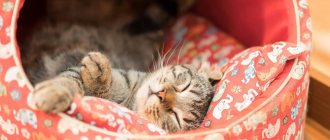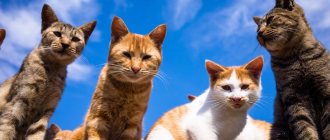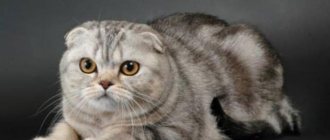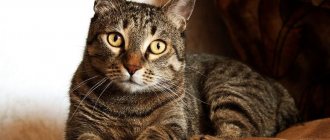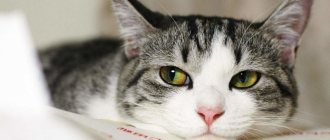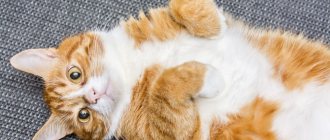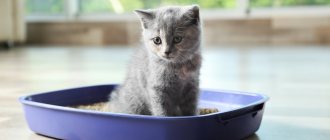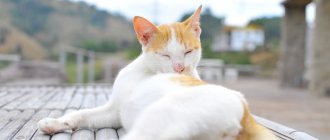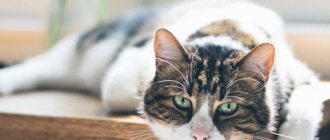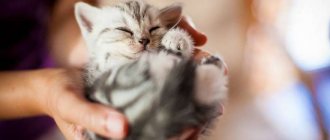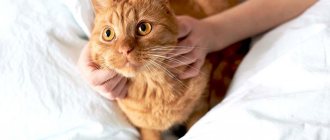Cats have become popular pets. They differ in breeds, habits, appearance, coat length, and height. The personalities of cats can be completely different. Some are sociable, playful, cheerful, while others are calm. Normal physiology decides what habits will be. Behavior is determined not only by breed, but also by upbringing.
Cat breeds and character
Powerful and proud
Such habits are typical for cats that are close to their wild ancestors. Even after living among people, they do not become completely domestic. They are suitable for a person who works and cannot stay at home all day. They tolerate loneliness and will find something to do in the absence of the owner. Families with small children are better off not getting one, because it is unknown how the pet will react if its tail is pulled or its ears are patted. They do not get along with other animals. Popular breeds with this character are British Shorthair, Persian, Bobtail, Maine Coon.
Sociable and friendly
Siamese, oriental, British cats, sphinxes, German rexes are sociable animals. They can be characterized as “family animals”. They are created for communication. They become attached to people and love to sit in their arms and be petted. Observation shows that such cats more often become members of families with children. They get along well with them. Loneliness is hard to bear. People who don't have enough free time call them clingy. Since they constantly follow the owner’s heels and require attention.
Cheerful and playful
It is recommended to have pets with a playful character if a person has enough time to devote to the animal.
Cat breeds that are characterized by playfulness and an inability to sit in one place are Abyssinians, Siamese, Ocicats, Bengals, Munchkins, and Dwelfs. There are differences in character, behavior and appearance, but everyone is united by a love of adventure. They are bought by active cat lovers, for whom it is not difficult to pay enough attention to the animal. If a person spends a lot of time at work, then such a cat is not for them.
Calm
A cat can be called calm if its nervous system is balanced and stable. This includes purebred American Curls, Siberian cats, Russian Blues, Norwegian Forest cats, Burmese cats, and Burmilla cats. They can be described as obedient, affectionate animals. They are non-aggressive, love their owner, are suitable for small children, and like to be held and petted. But at the same time, they will not bother you and require constant attention. They tolerate loneliness calmly.
Cat psychology
When living together with a pet, it is very important to get along with its character.
Advertising:
Almost all representatives of the cat family are distinguished by their love of freedom and independence from their owner. They do not immediately respond to commands or training and require a separate approach to education. However, cats become truly attached to their owners and can show boundless love.
The furry pet is able to determine the owner’s mood and feel his pain. Many purrs even try to calm their owner by climbing onto his lap and purring softly. A cat brings happiness and well-being to the house, helps to escape from the troubles of life, and gives a feeling of peace and warmth. But how do you know what kind of character a cat will have, and whether you will be able to get along with it in the future?
Each type of purr has a certain type of behavior. But there are several factors on which the pet’s character traits depend:
- breed;
- body type;
- color
If you determine temperament by a cat’s physique, then thin animals with a more graceful body have an unstable psyche, are jealous and can show aggression.
Fluffy and kind fat dogs with a large skeleton and a wide chest are distinguished by calm, balanced behavior and are able to openly show their love and affection to their owner.
The theory that a cat’s temperament depends on the color of its coat and its length has not been scientifically proven. This is more of a guess from owners and breeders.
Character by color
Research by zoological scientists proves an interesting fact. The colors of purebred animals influence actions, temperaments and character. Therefore, when choosing a pet, you need to pay attention to the color. It says a lot about the kitten's character. There are these types of colors:
Depending on the color of a cat’s fur, their character is determined; for example, white cats are distinguished by their kindness and affection.
- White color can be deciphered as affection, kindness and timidity.
- Goldens are calm and patient, they love to sit on hands while their fur is combed.
- Red cats are smart, endowed with intelligence, and they like to play with their owner.
- The color, like that of Siamese cats, is called color point and means sociability, affection for humans and devotion.
- Striped ones are curious, they poke their noses everywhere all their lives, they are mischievous.
- Grays are proud, independent, love freedom, walk on their own.
- Blues are friendly, sociable, and easy to make contact with.
- Marble cats are very flexible and flirtatious.
- Chocolate ones are cheerful and playful. They will not sit in one place for a long time.
- Smoky people are phlegmatic by temperament; before doing something, they will think about whether they need it.
- Tortoiseshells are loyal to their owner.
- Blacks are kind and obedient pets. There is an interesting superstition that cats of this color bring bad luck. Some people believe in him. But that's not true. They are very affectionate, strongly attached to their owners, find a common language with children and other animals (dogs, cats, hamsters). Throughout life they bring only joy to people.
Aggression or excessive activity?
Please note that a kitten's activity may be based on various reasons. Some kittens are indeed restless, while in others such restlessness is simply a type of aggression. These two qualities are easy to confuse, so you should spend some time taking a closer look at the kitten and finding out how it relates to other pets or people, whether it is in a good mood or whether it is constantly irritated by something, whether it often uses weapons and etc.
Aggression or excessive activity?
If a cat feels unprotected, it can become both fearful and inappropriately aggressive. It is fear that forces a cat to take a defensive line of behavior, and, as you know, the best form of defense is a rapid, proactive attack. It is also possible that aggressiveness is a consequence of a mental disorder. Don't be surprised: cats have their own mental problems too. They even have depression. And if a kitten is aggressive and attacks other kittens, you should look at its mood. The combination of hyperactivity with a bad mood almost always indicates mental disorders and, as a rule, is not so much activity as aggression. And if inappropriate behavior already appears in a kitten, then in the future the situation will only become more complicated.
If you find an error, please select a piece of text and press Ctrl+Enter.
Types of characters and descriptions of behavior
Often kittens from the same litter are completely different: some are quiet, others love to frolic.
There are 4 different temperaments: choleric, sanguine, phlegmatic and melancholic. The type of character is formed from birth. When choosing a kitten, you may notice that the animals were born on the same day, but with different cat personalities. One sits quietly in a corner, the second runs after mom, the third meows and asks to choose him. These signs characterize temperament.
Choleric cats
They are distinguished by activity and mobility. They are playful, love movement, and meow a lot. This type is characterized by excessive emotionality. If a dog pesters them, it can get a paw in the face. They will not let themselves be offended. These cats are not suitable for families with children. Because the child will pull the cat's tail, and he won't like it. It is better to start for active and emotional people.
Characteristics of phlegmatic people
Such animals are characterized by slow, calm behavior. Restrained, balanced, sleep a lot, play little. This is the complete opposite of choleric people. They are inactive, which makes them prone to obesity. Suitable for the elderly or those who spend a lot of time at work. Phlegmatic people tolerate loneliness well and do not need active games.
Characteristics of sanguine people
Unlike other cats, they get used to a new environment, owner and animals. They can be described as a cross between choleric and phlegmatic. The behavior of cats is characterized by playfulness and rapid adaptation to the world around them. Not very suitable for children. The kitten will easily make contact from childhood. Not too talkative, will not meow often.
Melancholic people
An animal with a melancholic temperament has devotion, but is afraid and does not recognize strangers.
You can determine the character by the vulnerability of the animal. It is difficult for them to adapt to new conditions and owners. They are characterized by anxiety and fear of strangers. When the house is filled with different guests, cats hide in a corner, under the bed, and do not come out until they leave. But at the same time they have devotion, kindness and love for their owners. They can be called monogamous. Such pets should not be hit or screamed at. They are touchy.
Cholerics
These are cats with increased excitability, temperamental, active, sociable, lively. However, if raised incorrectly, they can become quite aggressive. They may experience sudden fits of rage, which can cause problems both at home and when traveling, for example to vaccinations or to an exhibition. However, it is choleric people who, when properly raised, grow into very loyal, cheerful and cheerful animals, capable of standing up for their owners if necessary. When raising choleric cats, you should avoid loud sounds, frequent punishments, harsh noises and shouts. You need to behave with them in an emphatically calm and imperturbable manner. Such cats need to be accustomed to exhibitions from an early age, from the age of 3 to 4 months, then, as they mature, they will more easily perceive the new environment. It is better to bring a choleric cat to a cat on the first day of estrus, and it is advisable to bring it to the same cat. However, you should not introduce her to him right away, but only a couple of days after the cat gets comfortable in the new place. It is better not to disturb a cat with kittens unless absolutely necessary, otherwise she may start carrying the kittens. It is advisable for a choleric breeding cat to be allocated a separate room for mating, and for a young cat not to be mixed with “difficult” cats. Choleric cats are very active animals; for them, it is advisable to equip a cat “sports complex” in the house with a variety of ladders and houses.
Changes in behavior after spaying and neutering
Character can be different and depends not only on the characteristics described above, but also on upbringing.
The physiological characteristics of cats affect the character of the pet. When animals reach sexual maturity, they want to go for a walk. If they do not get what they want, the behavior does not please the owner. The behavior of a cat in the spring - she constantly meows, scratches the sofa. The cat is also not behaving in the best way. Animal lovers claim that after castration and sterilization, the animal becomes calmer, more balanced, and more affectionate. Stop meowing constantly.
Socialization in the early stages of development
It is very important that kittens are introduced to people and other animals before they are 4 months old. If before this time they do not learn that you can be friends with a person, then it will be impossible to explain this to them - they will remain wild. Thus, at an early age, kittens develop an idea of the world and its inhabitants - and this, of course, shapes many character traits.
